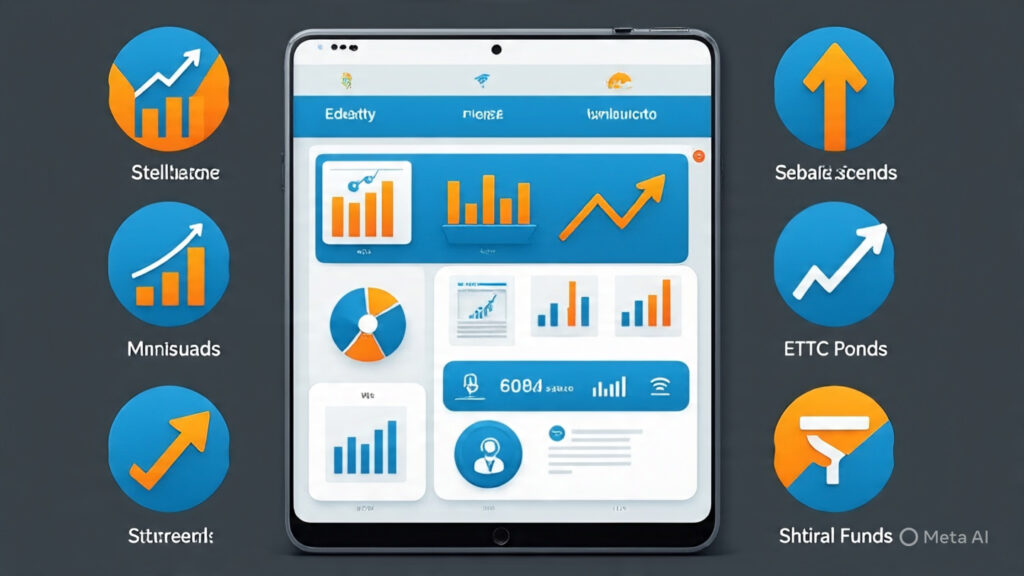Thinking about securing your financial future? Starting your investment journey now is one of the smartest moves you can make. The earlier you begin, the more time your money has to grow. Yet many beginners hesitate because investing feels complicated or risky. That’s a normal fear — but it doesn’t have to hold you back.
The good news: 2025 is shaping up to be one of the best years for new investors. With smarter tools, accessible apps, and an evolving market, the opportunities have never been greater. This guide will give you a clear plan to begin, showing you the most effective investing strategies for beginners in 2025 so you can grow wealth steadily and confidently.
We’ll cover the basics of goal setting, explore core investment options like stocks, bonds, and funds, and show you how to manage risks while staying consistent. By the end, you’ll have a roadmap for building long-term financial freedom.

Understanding the Investment Landscape in 2025
Before you dive into stocks or funds, it’s important to know the foundation of good investing: your goals, risk tolerance, and time horizon.
Defining Your Financial Goals
Ask yourself: Why am I investing? Are you building a retirement fund, saving for a house, or just wanting to grow your wealth? Clear goals guide your choices.
SMART goals (Specific, Measurable, Achievable, Relevant, Time-bound) make your investment journey realistic. For example: “I want to save $50,000 for a home by 2030” is far better than simply saying, “I want to save money.”
Knowing Your Risk Tolerance
Risk tolerance is about how comfortable you are with market ups and downs. Young investors may afford higher risks (more stocks), while those closer to retirement often prefer stability (more bonds). Knowing where you fall — conservative, moderate, or aggressive — will shape your strategy.
The Role of Time Horizon
The length of time before you need the money matters. A longer horizon (10–30 years) allows for riskier investments that bounce back after dips. A short horizon (1–3 years) calls for safer options like bonds or money market funds.

Core Investment Vehicles for Beginners
2025 offers beginners more access to investments than ever before. Here are the essentials:
1. Stocks: Building Long-Term Wealth
Owning a stock means owning a piece of a company. Stocks have historically delivered the best long-term returns, making them central to most portfolios.
- Growth stocks: Companies expected to expand quickly.
- Value stocks: Companies that appear undervalued and could rebound.
Tip: Avoid putting all your money into one company. Instead, diversify across industries and regions.
2. Bonds: Stability and Income
Bonds let you lend money to governments or corporations in exchange for regular interest payments. They’re more stable than stocks and help balance a portfolio.
- Government bonds = safest, lower returns.
- Corporate bonds = higher returns, higher risk.
- Municipal bonds = tax-friendly options.
Bonds act as a cushion when the stock market gets rocky.
3. ETFs and Mutual Funds: Easy Diversification
For many beginners, funds are the simplest entry point.
- ETFs (Exchange-Traded Funds): Trade like stocks and give exposure to multiple companies at once.
- Index funds: Track market benchmarks like the S&P 500 at very low costs.
- Mutual funds: Professionally managed, but usually with higher fees.
In 2025, low-cost ETFs and index funds remain some of the most effective investing strategies for beginners thanks to instant diversification and simplicity.

Building a Beginner-Friendly Portfolio
Diversify Across Asset Classes
Don’t just stop at stocks and bonds. Consider adding real estate (via REITs) or commodities like gold for balance. A mix of different asset types keeps your money more stable.
Asset Allocation Examples
- Young investor (high risk tolerance): 80% stocks, 20% bonds.
- Near retirement (low risk tolerance): 40% stocks, 60% bonds.
The right allocation depends on your personal goals and risk comfort.
Rebalancing Your Portfolio
Over time, investments grow unevenly. Rebalancing means selling a bit of what has grown too much and buying more of what’s lagged. This keeps your portfolio aligned with your goals.

Automating Investments: Consistency Wins
Consistency is more powerful than chasing “perfect timing.”
Dollar-Cost Averaging (DCA)
With DCA, you invest the same amount regularly (say $200 monthly), no matter the market’s condition. This way, you buy more shares when prices are low and fewer when prices are high, lowering your overall cost.
Set It and Forget It
Most brokerages in 2025 allow you to automate contributions. This ensures you stick to your plan without second-guessing.
Mental Benefits of Automation
Automating removes emotional decision-making. You won’t panic sell during downturns or overspend instead of investing. It builds discipline effortlessly.

Navigating Risk and Market Volatility
Every investor faces risks, but preparation reduces fear.
- Market risk: Prices drop due to global events or recessions.
- Inflation risk: Your money loses purchasing power over time.
The best defense? A long-term perspective. Historically, markets rise despite short-term crashes. One of the most effective investing strategies for beginners in 2025 is to stay invested, not chase trends.
Avoiding Common Beginner Mistakes
- Panic selling during downturns → Locks in losses.
- Chasing hot trends (like meme stocks or crypto hype) → Risky and often unsustainable.
- Over-concentrating in one stock → Lack of diversification increases risk.
- Skipping research → Blind investing can hurt more than help.
Tools and Resources for Beginners in 2025
- Brokerage apps like Robinhood, Fidelity, or Vanguard offer beginner-friendly platforms with commission-free trades.
- Educational sites like Investopedia and government resources (SEC, FINRA) provide free guides.
- Financial advisors: If you’re overwhelmed, fiduciary advisors can build a personalized plan.

Conclusion: Start Your Journey Today
The best time to start investing was yesterday; the second-best is today. By now, you’ve learned:
- How to define goals, risk tolerance, and time horizons.
- Why stocks, bonds, ETFs, and funds are key building blocks.
- The importance of diversification, automation, and risk management.
Remember: Wealth grows through consistency, not luck. Investing strategies for beginners in 2025 are about patience, discipline, and starting small — not chasing quick wins.
Your financial freedom starts with the first step. Begin today, and let your money work harder for you.





